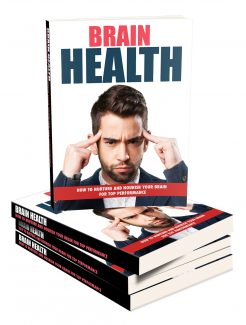 License Type: Master Resell Rights
License Type: Master Resell Rights  File Type: ZIP
File Type: ZIP
 SKU: 59433
SKU: 59433  Shipping: Online Download
Shipping: Online Download
Ebook Sample Content Preview:
The idea of tDCS is not to cause your brain cells to fire, as there is not enough electricity being delivered to the brain for that. Instead, it is simply to potentiate them, to increase the amount of BDNF and to encourage plasticity. This has been demonstrated to be effective in countless studies and there are again no proven side effects. Pads are placed in different arrangements around the head which are known as ‘montages’ and these are designed to ensure that specific brain areas get the majority of the current. This then changes the effect of the tDCS – some montages make people more alert and focussed while others can boost the mood or improve sleep. What’s particularly interesting is that the effects seem to last about 30 minutes following use.
Just as with stronger nootropics though, it’s important to exercise a little common sense here and to realize that there’s no such thing as a ‘biological free lunch’. Apart from anything else, it’s very hard to know precisely the area of the brain that you’re stimulating just by looking at a drawing of the scalp! And if you can increase learning in one area of the brain, you could theoretically accidentally cause learning in other parts of the brain too that would be less desirable. Proceed with extreme caution then!
But with all that said, this is definitely an interesting option and especially when you consider a) that there is a huge amount of evidence suggesting that this is a safe way to get a considerable brain boost and b) that there are many commercial products now available that use this technology – and upcoming. The ‘foc.us’ headset for instance is a product that is designed to boost performance in computer games that can already be purchased online!
8 Lifestyle and Understanding the Rhythms of Your Brain
The right nutrition can make a huge difference to your brain power then and so too can dabbling in nootropics and even tDCS as long as you’re careful with it.
Then there’s the importance of using ‘natural’ brain training by stimulating yourself with lots of new experiences and challenges.
But despite all this, there is still one alternative method that is far more effective when it comes to giving you an immediate boost in your cognitive function, productivity and pretty much every aspect of your brain power.
And that is to sleep more.
If you are not getting the best night’s sleep possible, then you are not performing at your best and it’s that simple. This is because you’re still going to have a build up of adenosine in your brain slowing you down and because your brain actually strengthens connections formed throughout the day during the night. It’s also while you sleep that you replenish many of your neurotransmitters and in short, this is an absolutely crucial process for putting you back on top of your mental game. Skip it and you can expect to feel sluggish, slow, forgetful and quite possibly even depressed.
Most people overlook this absolutely crucial factor though and will continue to abuse their sleep – trying to work longer hours or wake up earlier. In the long run, this will be guaranteed to damage your productivity and your brain power… so get to sleep.
Tips for Sleeping Better
If you want to improve your sleep and thereby wake up refreshed and better able to focus on what you’re doing, then follow these tips…
Have a Hot Bath
Having a hot bath right before bed is a fantastic way to encourage sleep. This will help to relax your muscles which makes it a lot easier to sleep. Furthermore though, it will also help you to produce more sleep-related hormones and neurotransmitters and even to better regulate your temperature throughout the night which also improves your ability to nap.
Have a Regular Sleep Time
Another important tip is to go to bed at the same time every night. Our bodies love routine because they are based largely on rhythms. Our sleep rhythm is called the ‘circadian rhythm’ and is based not only on what time we wake up/go to bed but also on external cues such as the sun and the weather.
If you go to bed at the same time every day, your body will start to find its natural rhythm so that it’s ready to sleep when you are and not before.
Use a Daylight Lamp
You can also help this process by giving yourself a ‘daylight lamp’. This is a light that is designed to mimic natural sunlight by producing light with a very similar wavelength. What’s more, is that a daylight lamp can be set to come on gradually in the morning to mimic the rising sun. Rather than being rudely ‘startled’ awake, you’ll instead be gradually nudged away by light – as you would have been during your evolution!
Create the Best Environment
This is also why it’s so important to have thick curtains. If light comes in from outside, it can reach your brain via the thinner parts of your skull and trigger the release of cortisol to wake you up. But if you keep those curtains opaque then you’ll only have the light you set to tell your body when to wake up.
Other important tips are to create a quite space to sleep in and to make sure that your bed is as comfortable as possible.
Have a Cool Down Period
Also important is to have a ‘cool down’ period. This is a period of time during which you’re going to avoid anything that might stimulate you. That means you’re avoiding all forms of stress but also anything that just wakes you up. So no phones, no computer games and no bright lights. The best way to do this is to read something under a dim light. Reading focusses your inner monologue and thereby prevents your mind from wandering to stressful things. Meanwhile, concentrating on the text will make your eyes heavy which also makes it easier to drift off (and harder not to!).
Routines and Rhythms for Your Brain
The reason this cool down period is so important is because it puts you in a relaxed state ready for bed. This means that you’ll have more inhibitory neurotransmitters and fewer excitatory ones.
And this is an important concept to understand because ultimately, both your brain and your body are only ever in one of two states: excited or inhibited. You are always either catabolic or anabolic.
Throughout the day, we switch from being ready for bed and sleepy and alert and ready to go. When it gets dark and we’re tired at the end of the day, we have cues from the darkness, from the adenosine build-up in our brain and even from dinner (which causes a release of sugar and serotonin/melatonin in the brain). Together, all this slows our heartrate and breathing, reduces brain activity and puts us in a creative and chilled mental state.
In the morning though, bright light causes a flood of cortisol and nitric oxide in the brain which ‘boots us up’. Heading to work causes an influx of noise and bright lights to find their way into our brain and stimulate even more adrenaline/norepinephrine to wake us up further. Then comes the coffee for some more cortisol and dopamine and the work for tons of each.
And it’s by switching between these two states that the brain is generally able to always perform the right job for the task at hand.
The problem is that we’re always sending the wrong signals or trying to force ourselves to stay in one state too long. That’s what happens when we play loud video games right before bed, or when we try and force ourselves to work hard at 4pm after we’ve just eaten.
A big part of performing our best is to understand the importance of letting our brain go through its natural rhythms and trying to work with it to get the most from it.
And also important is to try and avoid excess stress. Because when you get too stressed – whether that is caused by physiological or psychological factors – this actually causes us to become so wired and focussed that our prefrontal cortex entirely shuts down. This is a state called ‘temporo-hypofrontality’. While this can be a good thing sometimes during sports, it’s actually the last thing you want during a conversation or when you’re trying to be creative!
CBT teaches us a lot of techniques we can use in order to overcome stress and put ourselves into the correct mental state for the job. These include visualizations techniques as well as challenging thoughts that might not be particularly effective. Meditation is also an incredibly useful tool to this end that you can use to address stress and put yourself in a much calmer and more relaxed state of mind as and when you need to.
The Critical Importance of Exercise
And finally, it is absolutely essential that you get lots of exercise if you want to get the most out of your brain. Remember, your brain evolved to help you adapt and survive in the environment via your physical interactions with it. The vast majority of your brain is dedicated to moving your body, so if you want to encourage plasticity then there are few things than learning a new dance or martial art.
What’s more though, is that exercise boosts your memory according to studies and stimulates the production of countless crucial neurotransmitters and hormones. Even beyond this, exercise is important to improve your circulation so that you might get more oxygen to your brain.
9 Conclusion
Congratulations on making it to the end! We covered a lot of complicated topics there and really did dive in deep with regards to the workings of the brain and how to get the most from it. But if you have made it to this point, then great news is that you now have a much better idea of how the brain works than about 99% of the population.
And hopefully you can also now see the best ways to improve your brain power through training, through diet and through your lifestyle.
Get a nutritious diet, exercise, expose yourself to novel things, learn new mental skills that you can use for thinking, play video games, get more sleep and occasionally consider using nootropics when you really need a boost.








